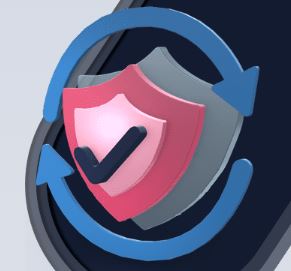What Is NIST 800-53? Understanding Federal Security Controls
This blog breaks down the essential elements of the NIST 800-53 framework and its security controls. It offers practical insights to help you understand how these standards shape organizational cybersecurity.
Published May 18, 2025.

Navigating the complexities of the NIST 800-53 framework can feel overwhelming, especially when you need to protect critical assets and stay compliant. You want a clear path to integrate the NIST 800-53 framework into your organization without getting lost in jargon or unnecessary details. Understanding how this framework fits into your security strategy is essential for managing risks effectively.
In this blog, we will explore the key aspects of NIST 800-53 and how its security controls support your overall cybersecurity posture.
» Contact us to see how our startup and enterprise security services can help
What Is NIST 800-53?
NIST 800-53 is a comprehensive guide developed by the National Institute of Standards and Technology to provide security and privacy controls for federal information systems.
Benefits of Using NIST 800-53
- Comprehensive risk management: NIST 800-53 offers a comprehensive set of security and privacy controls designed to manage diverse risks, including cybersecurity threats, system vulnerabilities, and privacy issues. It promotes a proactive, structured approach to risk mitigation for federal information systems. While often seen as an exhaustive framework, its effectiveness continues to be refined as new threats emerge and technologies evolve.
- Standardization and consistency: NIST 800-53 promotes standardization and consistency in security practices by providing a unified framework for managing risks. This consistency helps organizations meet compliance requirements, streamline security operations, and foster collaboration across departments. It also builds trust among stakeholders by ensuring a common understanding of security expectations and responsibilities.
- Flexibility and scalability: NIST 800-53 offers flexibility and scalability through its outcome-based controls, allowing organizations to tailor security measures to their specific size, industry, and risk profile. Whether applied to small systems or large enterprises, the framework adapts to diverse operational environments. This customization ensures that security controls remain effective and relevant, supporting current needs and future growth.
- Alignment with regulatory requirements: Implementing NIST 800-53 helps organizations align with regulatory and contractual obligations, especially for federal agencies and their contractors. It also supports compliance with other frameworks like the NIST Cybersecurity Framework (CSF) and ISO 27001. By adopting NIST 800-53, organizations can streamline their compliance efforts across multiple standards, reducing redundancy and strengthening their overall security posture.
» Learn more: NIST vs. ISO 27001
NIST SP 800-53 vs. NIST SO 800-171 vs. NIST CSF
| Aspect | NIST SP 800-53 | NIST SO 800-171 | NIST CSF |
|---|---|---|---|
| Purpose and Scope | A comprehensive catalog of security and privacy controls required for federal information systems. It provides in-depth technical guidance for implementing security measures. | Focuses specifically on protecting Controlled Unclassified Information (CUI) in non-federal systems and organizations. | A voluntary, risk-based framework designed to help organizations improve their cybersecurity posture. It takes a broader, more strategic approach. |
| Level of detail | Highly detailed, with 1,077 controls across 20 families. Supports customizable implementation for diverse environments. | Less extensive, offering focused controls for organizations handling CUI. Serves as a bridge between federal requirements and private systems. | Less technical and easier to adopt. Organized into CSF Core (Identify, Protect, Detect, Respond, Recover), Profiles, and Implementation Tiers. |
| Applicability | Mandatory for U.S. federal agencies and contractors. Also used voluntarily by state governments and private sectors for strong cybersecurity practices. | Required for federal contractors handling CUI under DFARS 252.204-7012 and NIST’s CUI program. | Recommended for any organization seeking to improve cybersecurity, especially small to mid-sized businesses. Not mandatory. |
| Compliance drivers | Driven by FISMA, FIPS 200, and FedRAMP. Ensures federal systems meet minimum security requirements. | Driven by DFARS and CUI protection mandates. Helps private contractors align with government cybersecurity expectations. | No direct legal requirement. Encouraged by executive orders and industry best practices as a flexible risk management tool. |
Did you know? Originally created for federal agencies, NIST SP 800-53 is now widely used in private sectors like healthcare, finance, and critical infrastructure. Its comprehensive security framework and detailed control families offer strong protection, making it ideal for organizations with complex IT environments and sensitive information.
» Do you have a startup? Here are some cyber tips to improve your security
Structure of the NIST 800-53 Framework
In the NIST SP 800-53 framework, control families are groups of controls that address different aspects of securing federal information systems and protecting sensitive data.
These controls are used to secure information in cyber-physical systems, industrial control systems, and more. NIST 800-53 includes various control families, each essential for addressing specific security needs.
1. Access Control (AC)
The Access Control family limits access to information and systems to authorized users only. Access control measures can be applied to physical systems, network resources, and software applications, ensuring layered security across the organization.
Key features
- It includes user identification, authentication, authorization, and account management.
- These controls help prevent unauthorized access and mitigate insider threats.
2. Awareness and Training (AT)
The Awareness and Training family aims to educate users on security risks and best practices. By increasing awareness, organizations can reduce human error and improve their overall security posture.
Key features
- It includes tailored security awareness programs and training sessions for various roles.
- These controls support recognizing phishing, social engineering, and other security threats.
3. Audit and Accountability (AU)
The Audit and Accountability family ensures that security-relevant actions are logged and monitored. By maintaining protected audit records, organizations can investigate incidents and maintain accountability for user actions.
Key features
- It includes event logging, access monitoring, and protection of audit information from tampering.
- These controls enable detection of unauthorized or unusual behavior through audit analysis.
» Here's how to take compliance further with penetration testing
4. Assessment, Authorization, and Monitoring (CA)
The Assessment, Authorization, and Monitoring family supports continuous validation of system security.
Key features
- It includes risk assessments, security authorizations, and continuous monitoring processes.
- By regularly assessing risk and authorizing systems for operation, organizations maintain compliance and reduce vulnerabilities.
» Read more: What's involved in the risk assessment process?
5. Configuration Management (CM)
The CM family ensures systems and applications are securely configured from the start, with any changes tracked and authorized.
Key features
- It emphasizes the importance of maintaining secure and consistent system configurations throughout their lifecycle.
- By preventing misconfigurations and unauthorized modifications, it helps protect system components and ensures overall system security and integrity.
6. Contingency Planning (CP)
The CP family helps organizations prepare for potential security incidents, ensuring they can recover quickly and continue critical operations.
Key features
- It includes backup procedures, disaster recovery plans, and regular testing of recovery processes.
- By establishing a well-defined contingency plan, organizations can minimize downtime, protect vital data, and ensure the continuity of essential services, even during unexpected disruptions or crises
7. Identification and Authentication (IA)
This family manages the identification and verification of system users, ensuring that only verified individuals can access sensitive information.
Key features
- It includes controls for methods like multi-factor authentication (MFA) and user credential management to prevent unauthorized access.
- By enforcing strong authentication practices, systems are protected from breaches and unauthorized access, ensuring only legitimate users gain appropriate access to sensitive data and resources.
8. Incident Response (IR)
This family defines the steps for detecting, responding to, and recovering from security incidents.
Key features
- By establishing well-defined processes for handling incidents, organizations can quickly identify and address cyberattacks, minimizing damage and reducing recovery time.
- It plays a critical role in an organization's ability to respond proactively to potential security threats.
9. Maintenance (MA)
The MA family governs the secure upkeep of system components, ensuring they are properly maintained without compromising security.
Key features
- It includes scheduled maintenance, emergency repairs, and secure remote maintenance controls.
- By conducting routine maintenance and ensuring updates and patches are applied, organizations can prevent vulnerabilities and security breaches.
10. Media Protection (MP)
The MP family helps safeguard data stored on physical media, such as hard drives, USB drives, and printed materials.
Key features
- It includes controls for the secure storage, handling, and destruction of media containing sensitive information.
- These controls ensure that sensitive data is protected from unauthorized access and potential breaches, even when it is stored on physical devices or media.
11. Physical and Environmental Protection (PE)
The PE family protects physical infrastructure and assets from environmental and physical threats.
Key features
- It includes physical access restrictions, environmental safeguards, and emergency response procedures.
- These controls are vital for ensuring the security, availability, and continuity of critical systems and infrastructure in the face of external threats or emergencies.
12. Planning (PL)
This family ensures that organizations document their security objectives and develop actionable plans to meet them.
Key features
- It includes defining security-related roles, responsibilities, and strategies that form the foundation of the organization’s security program.
- By creating clear plans, organizations can ensure a structured approach to security, enabling effective implementation and monitoring of security measures.
13. Program Management (PM)
The PM family guides the overarching security program, defining the organization’s objectives, risk management practices, and commitment to security.
Key features
- It ensures that security measures are aligned with the organization’s goals, providing a structured framework for managing security initiatives.
- By maintaining alignment between security measures and organizational objectives, it supports long-term success in managing and mitigating security risks.
14. Personnel Security (PS)
The PS family is designed to ensure that individuals handling sensitive data are trustworthy and suitable for their roles.
Key features
- It includes controls such as background screening, access agreements, and termination procedures to reduce the risk of insider threats.
- By implementing these measures, organizations can mitigate potential security risks posed by employees, contractors, or others with access to critical information.
15. Privacy Controls (PT)
The PT family is crucial for systems that handle personal information.
Key features
- It includes controls such as data minimization, consent requirements, and privacy impact assessments to ensure that organizations align with privacy regulations.
- These measures help protect user information by ensuring that only necessary data is collected and that individuals' consent is obtained.
16. Risk Assessment (RA)
The RA family involves identifying vulnerabilities and assessing the potential risks they pose to the organization.
Key features
- It helps organizations understand the likelihood and impact of various threats, allowing them to prioritize security efforts.
- By assessing risks, organizations can allocate resources to address the most critical areas, ensuring that security measures are implemented where they are most needed.
» Here are 6 things you should know before hiring a risk assessment service provider
17. System and Services Acquisition (SA)
This family covers the security aspects of acquiring system components and services.
Key features
- It ensures that purchased products, whether hardware or software, meet the organization’s security requirements.
- This family emphasizes the importance of considering security needs during the acquisition process to prevent vulnerabilities from being introduced through external products or services.
18. System and Communications Protection (SC)
The SC family focuses on securing communications within and between systems.
Key features
- It includes protecting data in transit and defending against brute-force and interception threats.
- By securing system communications, organizations can maintain the confidentiality, integrity, and availability of data, reducing the risk of unauthorized access and safeguarding against potential breaches during data transmission.
» Want to boost your organization's security? Implement the CIA triad
19. System and Information Integrity (SI)
This family helps maintain system integrity by identifying and mitigating vulnerabilities.
Key features
- It includes protections against malicious software, integrity checks to verify the accuracy and consistency of data, and patch management to address known vulnerabilities.
- These controls prevent exploitation by ensuring systems remain secure and up-to-date.
20. Supply Chain Risk Management (SR)
This family ensures that supply chain partners and external vendors meet the organization’s security standards.
Key features
- It addresses risks associated with third-party suppliers and service providers, aiming to prevent vulnerabilities from entering the organization through external channels.
- By implementing these controls, organizations can safeguard their systems and data from potential threats posed by external relationships.
NIST 800-53 Control Baselines
Low-impact baseline
- A low-impact system has all three security objectives—confidentiality, integrity, and availability—rated low. This baseline applies to systems where a breach would cause limited adverse effects, ensuring appropriate measures mitigate minor risks.
- Tip: Organizations should consider systems with non-sensitive data or limited operations to classify them as low impact, ensuring they implement basic security controls.
Moderate-impact baseline
- A moderate-impact system is one in which at least one security objective is moderate and none are high. This baseline is designed for systems where a breach could cause significant harm to the organization's operations, assets, individuals, or other organizations.
- Tip: Assess the criticality of the system to the organization’s operations. If compromised, would it disrupt operations or cause moderate harm? If so, apply the moderate baseline.
High-impact baseline
- A high-impact system is defined as one where at least one security objective is high. This baseline applies to systems where a breach could have catastrophic consequences on the organization’s operations, assets, individuals, or other organizations.
- Tip: For systems handling sensitive data, apply the high baseline to ensure adequate protection against potential catastrophic breaches.
The Role of Control Enhancements in NIST 800-53
Control enhancements in NIST 800-53 improve cybersecurity scalability, flexibility, and maturity by strengthening core controls. They enable tailored security measures based on risk profiles and operational needs, supporting growth and a proactive security approach.
How to Prioritize and Scope Security Projects Effectively
- Assess projects for business value: Evaluate how projects contribute to goals like revenue, reputation, or customer satisfaction. Consider long-term value and internal impacts like burnout. Focus on initiatives aligned with lasting success.
- Filter projects for urgency: Use the Eisenhower Matrix to prioritize urgent and important projects first. Schedule important but not urgent tasks. Delay or eliminate less valuable projects. Focus on what supports goals and is time-sensitive.
- Map out project dependency: List tasks, assign roles, and identify blockers like approvals. Prioritize projects with fewer constraints and address blocking tasks first to avoid delays.
- Estimate scope, timeline, and costs: Review past projects or consult experts to estimate scope and timelines. Calculate costs using: Time × Frequency × Hourly Rate.
- Assess your budget against costs: Compare the approved budget to the estimated costs. Prioritize fully funded projects and track expenses for real-time budget insights.
- Assess team skills and capacity: Ensure your team can handle the project scope and timeline. Prioritize projects fitting your team’s capacity and encourage cross-department collaboration.
» Here are the disasters you can avoid by tackling cybersecurity on time
Steps to Implement and Maintain NIST SP 800-53 Compliance
1. Assessment and Gap Analysis
- Review your current security practices and identify where they fall short of NIST SP 800-53 requirements.
- Conduct a risk assessment to evaluate threats and vulnerabilities, helping you prioritize relevant controls.
- Create an action plan with responsibilities and timelines, and document findings and procedures for clarity and accountability.
2. Prioritization and Planning
- Prioritize controls that address your most critical risks and align with your organization’s mission.
- Focus on implementing high-impact controls first while supporting long-term compliance goals.
- Set clear, achievable objectives that balance urgency and strategic value.
3. Control Implementation
- Implement selected controls using an approach best suited to your organization—common, system-specific, or hybrid.
- Ensure that each control is properly configured, integrated into workflows, and backed up by up-to-date documentation.
- Train relevant employees on usage and compliance responsibilities and maintain detailed records of policies, procedures, and training to support audits and long-term compliance.
4. Training and Awareness
- Schedule regular training sessions to help employees understand NIST 800-53 controls and their role in compliance.
- Reinforce a security-first culture by encouraging staff to report risks and stay alert to evolving threats.
5. Documentation and Reporting
- Maintain comprehensive documentation of your risk assessments, control deployments, audit logs, and training history.
- Develop standardized reporting processes for internal use and external audits. These reports demonstrate your compliance posture to stakeholders and regulators.
6. Continuous Monitoring and Improvement
- Establish systems to continuously monitor the performance and effectiveness of your security controls.
- Use automated tools and manual reviews to identify emerging vulnerabilities.
- Conduct regular audits and adapt to changes in the threat landscape, regulatory updates, or organizational shifts, and use these findings to improve and refine your controls over time.
» Learn more: What is good compliance and how to get started
How GRSee Helps You Meet NIST 800-53 Requirements
If you're working toward NIST SP 800-53 compliance, our expertise at GRSee Consulting can help you get there faster and with greater clarity. We tailor the NIST SP 800-53 security controls to your specific risk environment, aligning each step with your business goals. You’ll receive practical support, from your initial assessment to continuous monitoring, so nothing falls through the cracks.
We also help you document your controls, streamline reporting, and stay ahead of audits. With our guidance, you can reduce risk, stay compliant, and build a stronger security foundation over time.
» Ready to take control of your security? Contact us to get started





